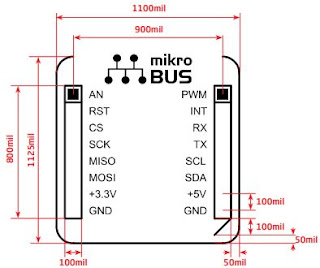Embedded system boards are turning complex day by day. Designing the systems with the future expand-ability, which helps provide optional connectivity on the boards is very critical. Also, designing small form factor boards is major requirement these days. Keeping all this in mind, one of the options for designers is to provide add-on card options on the board for expansion. Designers across the world can have their own pin outs and options. While it is OK to define their own expansion pin outs, it is good to follow a standard. mikroBUS™ standard is one such plug-and-play pin out standard.
mikroBUS™ standard specification defines a host connector which includes two 1x8 headers with standard spacing. The daughter card connector has standard pin out as shown below.
As indicated in the above standard pin out, there are 3 serial communication channels. The 3 serial communication channels are UART, SPI and I2C. Most of the embedded devices have either of these serial communication interface. Along with these serial communication channels there are discrete pins in this mikroBUS™ standard specification which helps for additional connectivity and support.
mikroBUS™ standard connector can be used on your own designs as long as the mikroBUS™ silkscreen is present on the PCB. The below dimensions help the PCB Layout engineers to create the footprint for the PCB.
There are various add-on cards available from microE and called click boards. Check out the available add-on cards from below link.
Example of the usage of mikroBUS™ standard connector is in Volansys Enterprise IoT Gateway which provided provision for the same. The below connectivity options of the Volansys board indicates options to add plug-in boards using mikroBUS™ standard.
The various other boards which support the mikroBUS™ standard connector are included in the mikroe website.








1 Comments
If you are interested in extended list of development boards that endorsed mikrOBUs socket feel free to check majority of them on Mikroe's official mikroBUS page.
ReplyDeletehttps://www.mikroe.com/mikrobus